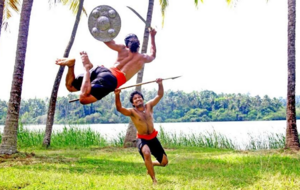Talk:Outdoor Sports:Martial Arts
By Vishal Agarwal and The Hindu Society of Minnesota
Kalaripayattu from Kerala is said to be the most ancient martial art in the world. Martial arts were learned from the Hindus and later promoted by Buddhist monks as a means of self-defense because Buddhism eschewed violence using weapons. This art of Kalaripayattu was transmitted to China by a sage named Boddhidharma in the 5th century from India to the countries of the far-east along with the Buddhist religion. The Chinese called him Po-ti-tama He taught this art in a temple. This temple is today known as the Shaolin temple Thus Judo, Karate, Kung Fu and other similar marshal arts which are today identified with the fareast actually originated from India.
Buddhists monks who traveled barefoot and unarmed to spread the gospel of Buddha seem to have accepted this art with alterations suitable to the philosophy of nonviolence. Such a technique of defence would have been necessary for them as they traveled individually or in small groups in foreign lands during which they were exposed to dangers from bandits and fanatics from other religions. Buddhist monks seem to have tempered the originally violent character of this art. The violent and exterminative nature of Kalaripayattu is evident from the daggers and knives that are used. Unlike Kalaripayattu, Judo and Karate do not allow the use of lethal weapons. Kalaripayattu is still practiced by Hindu communities in Kerala. Not just men, even Hindu women were trained in martial arts. Below is a story of a brave Hindu girl who was proficient in martial arts and used her prowess to save women from being kidnapped.
Story: The Bravery of Unniyarchā
In the early 17th cent. CE., there lived a fencing and martial arts master named AromalChekavar. He trained his sister Unniyarcha also in sword-fighting. Unfortunately, she got married to a coward named Kunnhiraman. One day, Unniyarcha expressed a wish to offer worship at a nearby Mandir of BhagavānAyappa. But her mother in law refused permission saying, “The path to the Mandir is dangerous. Often, members of the Chonaka tribe attack pilgrims and carry away their women as prisoners.” But Unniyarcha would not be daunted. With a sword in her hand, she proceeded to the Mandir, taking her husband. On the way, the Chonaka tribesmen attacked the group, but Unniyarcha unsheathed her sword and valiantly killed her attackers. When the Chonaka chief heard about his men being killed by a woman, he too rushed to fight her. But, he soon realized that it was none other than the sister of his own martial arts Guru Aromal. He appealed to Unniyarcha to sheath her sword and pardon him. But Unniyarcha was in no mood to forgive him till he gave a promise that henceforth, no member of his tribe would attack pilgrim women on their way to the Mandir. Because of Unniyarcha’s bravery, many women were saved from kidnapping in the years that followed, and a ballad was written in Malayalam language in her honor. In modern times, even a movie has been made to depict the life of this brave heroine and plays are enacted to depict her bravery and fearlessness.


